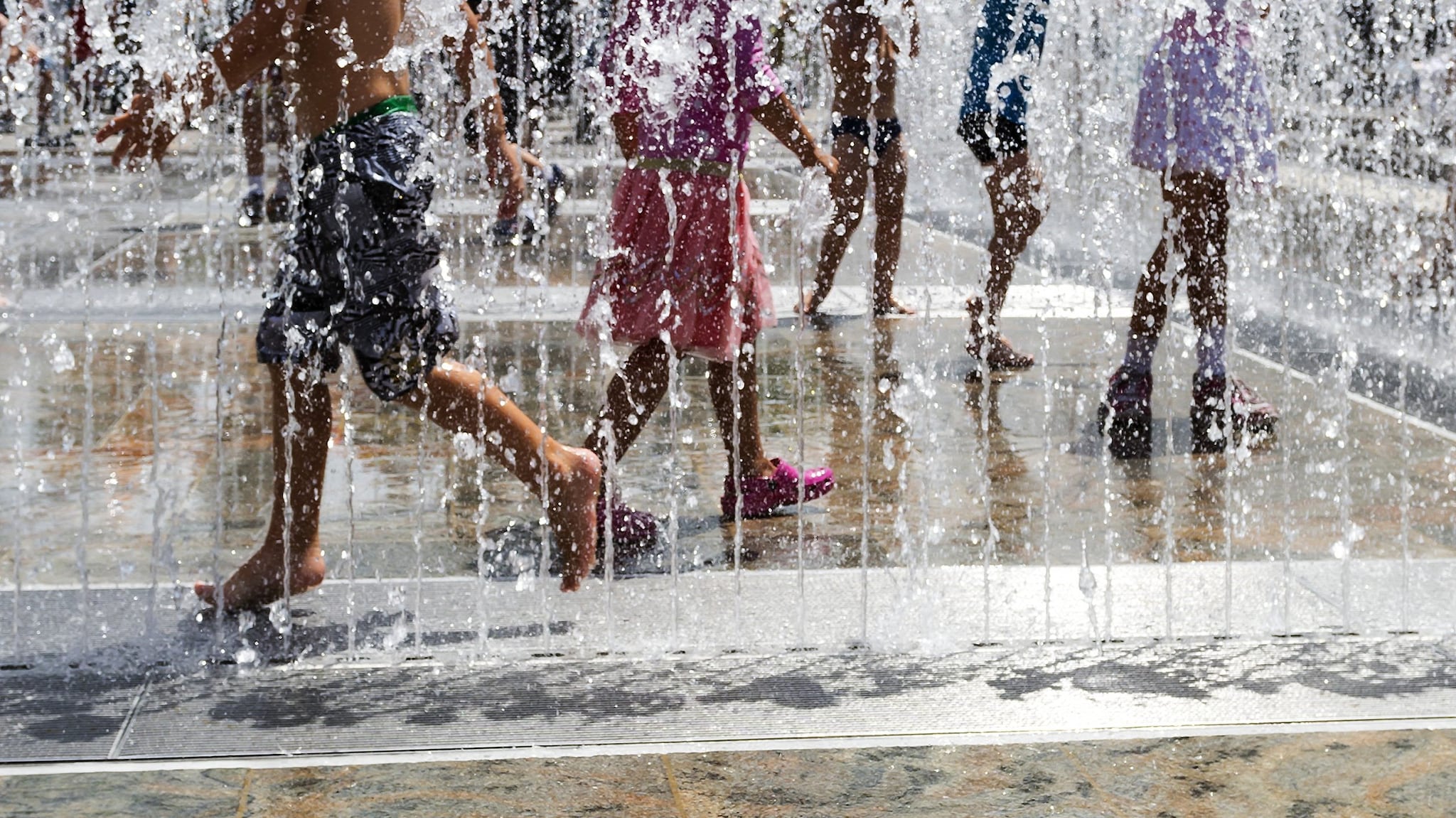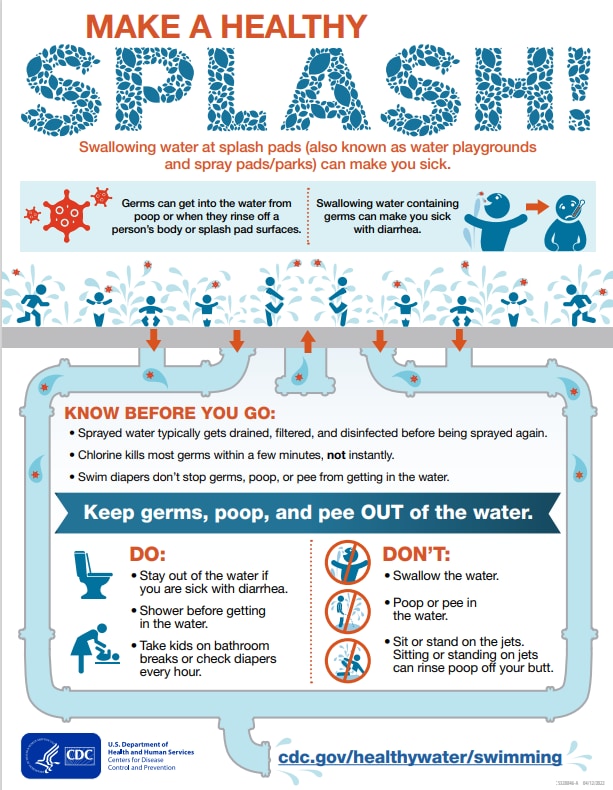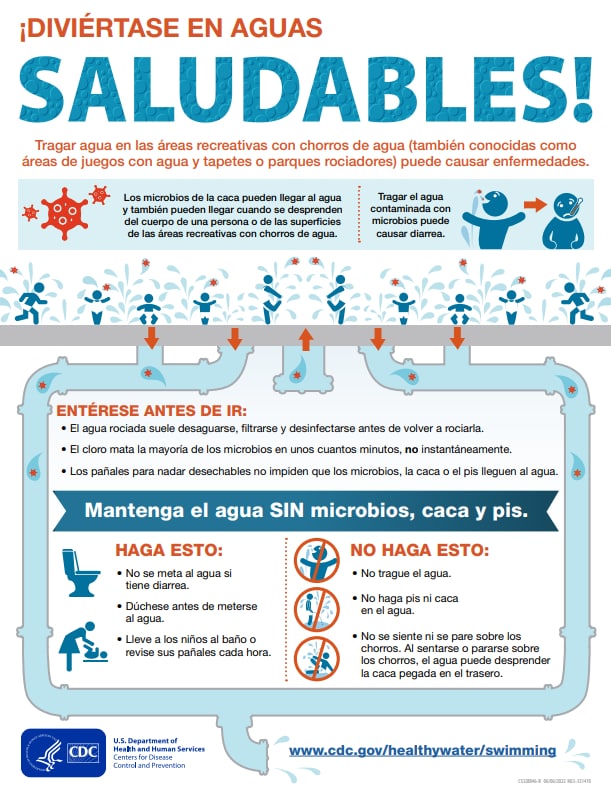Key points
- Splash pads are not always required to disinfect the water with germ-killing chemicals.
- The water at splash pads can spread germs and make users sick if the water is not adequately disinfected.
- Splash pad users can take a few steps to help stop the spread of germs in the water.

The risks
Splash pads (also known as interactive fountains, spray pads, spray parks, or wet decks) are aquatic venues that spray or jet water on users. Splash pads are usually designed so that standing water does not collect in the water play area to reduce the risk of drowning. Because of this design, splash pads do not always meet the local, state, territorial, or tribal definition of an “aquatic venue.” This means they are not always regulated, nor are they always required to disinfect the water with germ-killing chemicals. Splash pads can spread germs and make users sick if the water is not adequately disinfected.
How and why this happens
The water in some splash pads passes only once through the splash pad's pipes and then drains out (typically into a sewer system). In other splash pads, the water is recirculated, meaning the pipes drain sprayed water into a tank that is typically underground. Then the water goes through a filter and is disinfected with germ-killing chemicals (chlorine or bromine) before it is sprayed again.
When kids and adults play in splash pads, germs, poop, pee, and dirt can rinse off their bodies and shoes. Sprayed water can also rinse off any debris (such as human or animal poop, dirt, or leaves) from splash pad surfaces.
It can be difficult to keep the water in splash pads adequately disinfected. Spraying water reduces its chlorine or bromine level. Plus, when poop, pee, dirt, and debris get in the water, chlorine or bromine combine with them and break them down, meaning there is even less disinfectant available to kill germs. Swim diapers do not stop germs, poop, or pee from getting in the water.
Steps to take
Splash pad users and parents of young users can take a few steps to help stop the spread of germs in the water:
DO:
- Stay out of the water if you are sick with diarrhea.
- Shower before getting in the water.
- Take kids on bathroom breaks or check diapers every hour.
DON'T:
- Don't swallow the water.
- Don't let water go up your nose.
- Don't poop or pee in the water.
- Don't sit or stand on the jets. Sitting or standing on jets can rinse poop off your butt.
Illnesses Linked to Splash Pads
Between 2020 and 2023, three young children died from a brain infection—primary amebic meningoencephalitis (PAM)—caused by the germ Naegleria fowleri after playing in splash pads in Texas and Arkansas. Public health officials investigated these cases and found problems with how the splash pads were operated and disinfected. One was a decorative fountain that was used as a splash pad and was not regularly checked. Another splash pad used recirculated water that was not sufficiently disinfected or monitored. In the third splash pad, the machine that disinfected the water was broken. Naegleria fowleri was found in each of the splash pads. There is no evidence of Naegleria fowleri spreading in properly disinfected splash pads.
In 2005, over 2,300 people were infected with the germ Cryptosporidium after using a splash pad. New York public health officials found that splash pads were not regulated in the state. In response, New York passed emergency public health laws to regulate splash pads. This included requiring ultraviolet light systems to kill Cryptosporidium, which can survive more than 7 days in water that has been adequately disinfected with chlorine or bromine.
Resources
Fact sheets
More information
- Operation and Management of Splash Pads
- Swim Diapers and Swim Pants
- Preventing Swimming-related Illnesses
- Preventing the Spread of Germs in Splash Pads


